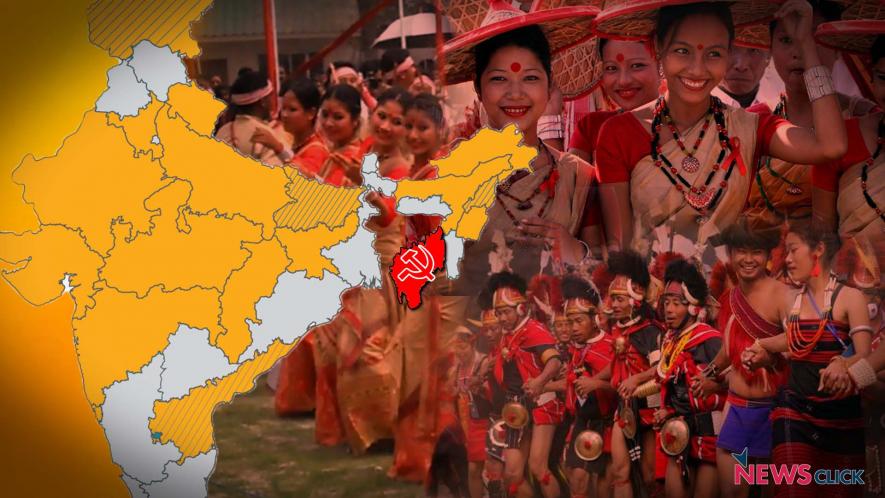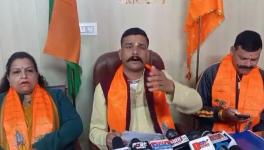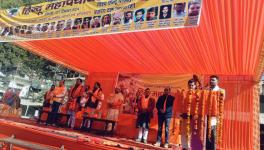Why the Left is the Most Popular Force Among Tribals in Tripura

Shivam Shankar Singh’s article in Indian Express (BJP’s Extreme Choices; February 15) is a dire attempt to justify BJP’s alliance with the Indigenous People’s Front of Tripura (IPFT) in Tripura election 2018. While doing so, the article is completely devoid of the history of Left politics in the state and it also makes erroneous claims with regard to socio-economic development of tribal people and their so-called support for a separate state in Tripura. In this brief response, I examine each of these claims made by Singh.
Studying history in an objective way has never been a repertoire of the RSS/BJP and this comes out strongly in Singh’s complete ignorance of the history of Left politics in Tripura and its close association with the tribal people. The communist-led political movement in Tripura dates back to the 1930s and 1940s during the days of the monarchy with the formation of organisations like the Janamangal Samiti, Prajamandal and so on. Participation of both tribal and non-tribal (Bengali) people was an important feature of this movement. The Janasiksha Samiti, formed in 1945, was a pioneer organisation that opened up more than 400 schools in tribal areas and then induced the king of Tripura to recognise these schools. The Samiti also stood for social reforms, particularly ending superstitions prevalent in the then tribal society and building scientific thought. Biren Datta, a communist, was the brain behind it and the organization was led by educated tribal youth like Dasaratha Deb, Sudhanwa Debbarma, Aghore Debbarma and others who were inspired by communist ideals. The same tribal youth formed the first mass tribal organisation in Tripura called the Ganamukti Parishad (GMP) in 1948 in the wake of severe state repression on tribals by the Dewani administration in the state. The GMP led a resistance movement from 1948-1951 against this repression and included an agenda of socio-economic reforms to uplift the tribals. The Left in Tripura was built up with the support of the tribal people; Bengali support for it came only from the 1970s.
Faced with the massive influx of refugees from East Pakistan since the partition of India and in the 1950s and 1960s, GMP leaders like Dasaratha Deb and the communists regularly intervened in the Parliament and Assembly (1963 onwards) and pointed out the dangers of this unabated migration on tribal people, particularly with respect to alienation of tribal land. The GMP organised massive campaigns and protests in the streets in the 1950s and 1960s. The Left’s approach at this time was proper rehabilitation of the refugees without affecting the rights of tribals. The Left and GMP consistently raised the issue of alienation of tribal land, demanded the provision of autonomy for tribals, recognition of tribal language (Kokborok) and organised mass movements on these demands. It was due to such efforts that legislations like the Tripura Land Revenue and Land Reforms (TLRLR) Act 1960 were brought and amendments made from time to time to protect tribal land. The Left also protested against some of the problematic provisions of these amendments, particularly the Second Amendment of 1974.
It was with the coming of the CPI(M)-led Left Front government to power in 1978 that important measures were taken for the tribal people. The Left Front government amended the Official Language Act in January 1979 to include Kokborok as an official language of the state (the Congress had made Bangla the official language in 1964). It brought the Tripura Tribal Areas Autonomous District Council (TTAADC) Bill in March 1979 to form the Autonomous District Council (ADC) under the Seventh Schedule, and led a struggle to bring the ADC under the Sixth Schedule, which was finally achieved in August 1984. The TTAADC was the outcome of a joint struggle of the tribal and non-tribal people; the Bill was unanimously passed by tribal and non-tribal MLAs in the Assembly.
The Left Front began a process of land reforms: stopping illegal transfer of tribal land, restoration of illegally transferred land back to tribals, and redistribution of khas land to landless families. While doing all this, the Left and its activists had to face opposition from chauvinist Bengali groups like Amra Bangali and violent attacks from militant groups throughout the 1980s and 1990s. Thus, the history of Tripura shows that if anything, the Left and communists cannot be charged with “marginalising” tribals. The tribal people have been an integral part of the Left movement in Tripura, both in terms of mass base and in providing leadership to the movement. And the success of the movement has hinged on uniting both tribal and non-tribal people.
The second problematic point made by Singh is that he justifies the BJP-IPFT alliance through the call of ‘national unity’ and ‘socio-economic development of tribals’. He completely ignores the fact that this is the same IPFT which had led a road-rail blockade in July 2017 causing immense hardship to the people of Tripura and whose cadres have been arrested in the murder of journalist Santanu Bhowmik in September 2017. Singh also keeps mum on the alleged links of the IPFT and INPT with banned militant outfits like the National Liberation Front of Tripura (NLFT) and cadres of the erstwhile militant group Tripura National Volunteers (TNV) and their violent past from the 1980s to mid-2000s. Though Singh talks about ‘national unity’, it is unclear how an unreasonable demand of carving out a small state like Tripura by the IPFT serves ‘national unity’. Despite Singh’s claim of IPFT now having ‘nuanced its agenda’, the organisation still holds on to its demand of a separate state. Besides demanding a separate state, groups like IPFT do not have anything to offer to the tribals and are hardly seen to have launched struggles on the rights and everyday issues of tribals.
Thirdly, Singh erroneously argues that the Left’s rule has not brought development for tribals in Tripura. It should be noted that development work was affected in Tripura due to violent insurgency in the 1980s, 1990s and 2000s. However, the Left Front government tackled it through multi-pronged measures of which development work in tribal areas was a chief element. This included construction of roads, schools and hospitals in interior areas. It was a result of this return of peace that the Disturbed Areas Act was revoked and AFSPA was finally lifted in May 2015.
Over the years, despite limited resources, there has been significant improvement in Tripura’s human development indicators and these are now among the best in the country. There have been significant improvements in literacy levels and health indicators for both non-tribals and tribals in the state. It now tops the country in literacy rate and a state-funded healthcare system has ensured that its health indicators are better than the national average.
Tripura is also among the few states in the country where the Forest Rights Act has been implemented in true spirit. According to the Ministry of Tribal Affairs, out of the total claims received, more than 1.2 lakh families have been given titles till February 2016. In terms of percentage of titles distributed compared to the number of claims received, Tripura stands second in the country with 63.96 per cent, just behind Kerala (65.54 per cent) and above all BJP states with significant tribal population. In recent years, tribals have received the highest amount of government khas land among all social groups by the state government. Despite shelving of the Tribal Sub Plan by the Modi government and providing funds only under ‘tribal welfare’, the Left Front government in Tripura has continued to fully implement this Plan. Unlike Assam which is currently ruled by the BJP and where Sixth Schedule Areas have been denied requisite funds, the TTAADC in Tripura gets 50 per cent funds from the state government. While the Left Front has always tried to strengthen the TTAADC, BJP-led state governments in states like Jharkhand have been trying to dilute the protection of tribal land through amendments. Wages for unskilled rural workers are also higher in Tripura than several BJP-ruled states like MP, Chhattisgarh, Jharkhand and Rajasthan. Tripura has seen one of the sharpest declines in poverty rates in the country and the share of population below poverty line is only about 14 per cent (NSSO 2011-12) – significantly lower than many BJP-ruled states.
Fourthly, Singh makes the claim that “tribals of Tripura have supported IPFT’s demand for a separate tribal state”. However, recent Assembly and ADC election results demonstrate that this is far from truth and majority of tribals have rejected this demand. In the 2015 ADC election, the IPFT contested all 28 seats, lost all and garnered 18 per cent of vote share. In contrast, the CPI(M) won 25 seats and the Left Front together won all 28 seats with 54 per cent vote share. It is also interesting to note that the IPFT has only won the 2000 ADC which had seen unprecedented violence before the election by NLFT. In the 2013 Assembly election, the IPFT contested 17 seats, lost all and could garner only 0.46 per cent vote share. In contrast, the CPI(M) won 49 seats out of 55 it contested (Left Front won 50) and received 48.11 per cent vote share. This shows that majority of tribals in Tripura do not support the demand for a separate and instead stand for unity between tribals and non-tribals.
Disclaimer: The views expressed here are the author's personal views, and do not necessarily represent the views of Newsclick.
Get the latest reports & analysis with people's perspective on Protests, movements & deep analytical videos, discussions of the current affairs in your Telegram app. Subscribe to NewsClick's Telegram channel & get Real-Time updates on stories, as they get published on our website.























